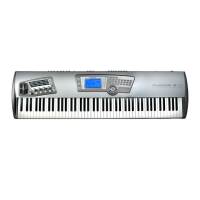ALESIS FUSION
ANALOG SYNTHESIS TUTORIAL
Low Frequency Oscillators (LFOs)
In the early days of modular synths, there was no such thing as an LFO - you simply
put the
audio oscillators into a very low frequency mode so
that instead of the oscillators chucking out
their waveforms at 100 or 440 or 1,000 cycles per second,
whatever (i.e. 100Hz, 440Hz, 1kHz
respectively), they produced
much slower cycles.... like much,
much slower cycles... like one
cycle every few seconds! In this mode, the audio oscillators were running at
fractions of a cycle
per second ...
like 0.05Hz (one cycle every 20 seconds!).Thus they could be applied to filter
cutoff for long filter sweeps. Running slightly faster
at, say 6Hz (still sub-audio), they could be
used for vibrato (pitch modulation) and tremolo (amplitude modulation) or filter ‘bubbles’.
However, as synths developed, it was deemed unnecessary to employ an expensive audio
oscillator and
so some manufacturers included simpler low frequency oscillators with a limited
frequency range purely for the purpose of controlling other modules.
An LFO is almost identical to an audio oscillator
except, as mentioned, they operate at a much
lower and slower frequency or
rate
. The waveshapes are identical but, because
they are
running so slowly, you can predict the effect they will have when applied to pitch, tone,
amplitude, whatever. For example:
If applied to oscillator frequency, this waveform will
cause pitch to rise and fall according to the
rate of the LFO.
If applied to oscillator frequency, this sawtooth wave will
cause pitch to rise slowly and then fall
abruptly according to the rate of the LFO.
This would cause the pitch to jump abruptly between the two extremes.
As such, LFOs are simple to
understand - just looking at the waveshape allows you to predict
the effect it will have (and fortunately, unlike some other synths, Fusion displays the
waveshape graphically so you can predict at a glance what effect the LFO will have!).
Controllers
Page
29

